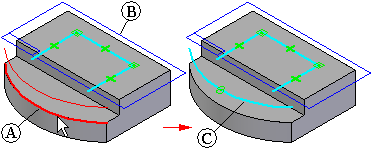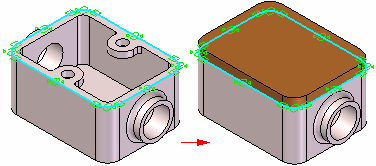 Include command
Include command
 Include command
Include command
Copies part edges or sketch elements onto the current profile plane. You can include elements associatively or non-associatively.
You are not limited to locating elements in the profile window. You can locate part edges in the 3D window also.
For example, you can select a part edge (A) to include onto the current profile plane (B). The included edge can then be used in the current profile.

Special relationship handles are used to indicate that an element is associatively linked to another element. The handles indicate whether the element is associatively linked to an element in the same document (local) or another document (peer-to-peer).
|
Link (local) |
|
|
Link (peer-to-peer) |
|
An included element from the current part is always included associatively. An included element from another document can be associative or non-associative.
You can break the associative link on included elements by deleting the link relationship symbols.
You can trim and modify associative or non-associatively included elements, and incorporate associatively included elements into a profile that contains newly created non-associative elements.
This allows you to create features on one part that react to design changes to another part. This builds intelligence into a model and allows you to ensure that mating parts with common characteristics fit properly.
You can also add relationships or dimensions to associatively included elements, but if the relationship or dimension conflicts with the associative relationship to the parent element, a warning message is displayed.
Including elements from another part can be useful when two parts share common characteristics. For example, you can use the Include command to copy the edges on an existing part to create the 2D geometry required to define the base feature for a new part.

If you are editing a part in the context of an assembly (you have in-place activated the part), you can include elements from the assembly into the profile for a feature. For example, you can include elements from an assembly sketch or an edge from another part in the assembly.
Note:
An Inter-Part Associativity tutorial is available that demonstrates how to create associative inter-part features.
When working outside the context of an assembly, you can also include edges from a part copy feature you created using the Part Copy command.
To associatively include an assembly sketch element or edge from another part, you must first set the Allow Inter-Part Links Using: Include Command From Part and Assembly Sketches option on the Inter-Part tab on the Options dialog box. Then set the Allow Locate of Peer Assembly Parts and Assembly Sketches option and the Maintain Associativity When Including Geometry From Other Parts in the Assembly option on the Include Options dialog box. For more information on inter-part links, see the Inter-Part Associativity Help topic.
To associatively include edges from a part copy, you must set the Link to File option on the Part Copy Parameters dialog box when you insert the part copy.